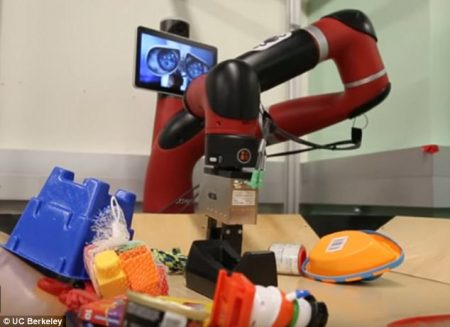December 7, 2017 – This new capability has been named by its creators, Meta-Learning, a method by which robots acquire new skills from an initial demonstration of a task using visual foresight. Robots that demonstrate visual foresight can anticipate what an end result of actions will be when it performs a particular sequence of moves. For the moment, the inventors of visual foresight at UC Berkeley are using as their test platform, Vestri, a robot equipped with a fully articulated arm. Normally Vestri would learn by mimicking a human’s actions as it watches. But visual foresight allows Vestri to imagine several seconds into the future based on what it has done in the past. States Sergey Levine, Assistant Professor, Department of Electrical Engineering and Computer Sciences, at Berkeley, visual foresight “can enable intelligent planning of highly flexible skills in complex real-world situations.”
What is behind Meta-Learning and visual foresight?
Deep learning technology provides the core for visual foresight based on recurrent prediction. The UC Berkeley inventor, Chelsea Finn, has given this capability the name Dynamic Neural Advection or DNA for short. Not to be confused with the molecule that is the basis of life here on Earth, DNA predicts how pixels within an image move frame-by-frame going forward based on previous frames. It combines deep action-conditioned video prediction models and model-predictive control using unlabeled items within its visual frame of reference. And unlike other forms of robotics learning DNA has no requirements for precision instrumentation to track and model the behaviour of a robot.
Chelsea Finn, a doctoral student in Levine’s lab, is the lead author in a recently published paper entitled, Unsupervised Learning for Physical Interaction through Video Prediction. which describes the research results. Finn states in a Berkeley press release, “In the past, robots have learned skills with a human supervisor helping and providing feedback. What makes this work exciting is that the robots can learn a range of visual object manipulation skills entirely on their own.”
This is the equivalent of the way children first learn to manipulate objects, and then later as adults continue the practice throughout a lifetime with no one providing guidance. And although Vestri’s current capabilities can only see forward a few frames, the skills it is mastering are based on self-learning giving it the ability to predict what needs to be done moving forward, a capability that will be of value to future robots on factory floors, drones, and autonomous vehicles.
Vestri recently demonstrated its robotic skills at the Neural Information Processing Systems Conference held in Long Beach, California on December 5th.

















